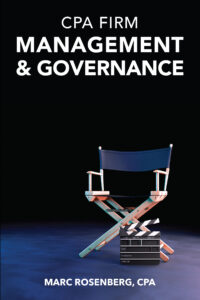How 20 Chicago Mid-Size Firms Saw the 2023 Tax Season
![]() Marc Rosenberg, CPA / May 24, 2023
Marc Rosenberg, CPA / May 24, 2023
My colleague, Art Kuesel of Kuesel Consulting (art@kueselconsulting.com), and I have been leading three roundtables in the Chicago area for over 20 years. Each group has about 25 partners, mostly MPs.  The group that this blog reports on comprises roughly 75% of the largest local firms in Chicago. Revenues range from $7M to $35M. We recently convened our May meeting of the large firm group, the first get-together since the tax season ended. As one might expect, our focus was a tax season debrief. Here are the highlights of that meeting.
The group that this blog reports on comprises roughly 75% of the largest local firms in Chicago. Revenues range from $7M to $35M. We recently convened our May meeting of the large firm group, the first get-together since the tax season ended. As one might expect, our focus was a tax season debrief. Here are the highlights of that meeting.
Overall summary
The good news is that, with one fairly significant exception, the 2023 tax season was one of the best in recent years. Common causes of “bad” tax seasons in the past have been tax prep software glitches and late updates, tax law changes and related ambiguities, the chaos at the IRS including delays in processing prior year returns, and workload compression due to the season starting late due to the problems just described. But the 2023 tax season was not impacted much by these headaches.
The exception noted above is a major one and not restricted to the tax season: the ongoing shortage of staff. This plagues CPA firms year-round and has for years, with no end in sight. The dearth of staff is especially acute in the tax season, where 45% of firms’ annual workload takes place between January 1 and April 30. Not surprisingly, talk of how the staff shortage impacted the tax season dominated the roundtable air waves.
Revenues up
Most of the firms’ revenues were up 10–20% from the prior year. A few firms were below that range, but the causes were operating issues unrelated to the tax season. What’s interesting about this enviable revenue increase is that (1) firms are continuing to cull their least desirable clients with a vengeance, and (2) firms have established a higher threshold for accepting new clients. What firms lost by terminating clients was more than compensated for by aggressive fee increases and the continuing boom in demand for CPA services. Due to the shortage of staff and booming demand, firms are, for the first time in my 20+ years of consulting, moving away from the flawed model of operating as low priced–high volume firms to higher priced–lower volume shops. What took them so long?
Interns
Quite a few firms reported a dramatically increased use of interns to help them meet the huge tax season workload. Firms reported a high degree of success with their intern programs. The firms admitted that training a hefty number of inexperienced students was initially daunting, but the effort paid off handsomely. Though conducting audits and preparing tax returns is a demanding job technically, it’s not rocket science, especially at the lower levels. Several firms said that the work assigned to interns is not so difficult as long as they are properly trained.
One firm’s novel approach to the staff shortage
A $12M firm started doing something that few local firms have done: hiring entry-level college graduates with majors other than accounting, such as finance and math—because, again, the work isn’t all that difficult if people are properly trained. If a firm hires bright, ambitious, energetic young staff and trains them well, they learn quickly. This firm did it, and this tactic helped immensely with their workload management. One firm in the group asked: “If you hire non-accountants, as they advance in the firm, they will never pass the CPA exam, a pre-requisite for supervisors and managers. As such, they won’t fill the leadership void down the road.” The response was “We know this is a problem, but we’ll deal with it down the road. Right now, we are desperate for warm bodies.”
CPA Firm Management & Governance is a must-read for partners who want to run their firm like a real business. The book addresses ►Best Practices for managing and structuring the leadership group ►how decisions get made ►voting ►how the Board functions ►the role and expectation of a partner ►the Managing Partner ►organization structures for various firm sizes ►job descriptions of key management positions ►partner accountability and other issues.
Firms are culling their least desirable clients at the fastest clip ever.
The obvious explanation for the culling is that firms simply don’t have enough people to get the work out. This is most acute during the tax season. Firms have reached the tipping point: Either work everyone to death or make life tolerable and comfortable by weeding out less desirable clients.
One firm cited their criteria for terminating clients:
- Low realization – this would include clients that eventually pay their bills but constantly complain about their bills, every year, which often results in bills being discounted
- Clients who are slow-paying
- Clients who are high risk
- The “jerk factor” – clients who are a pain in the butt (a more graphic term was actually used but after all, this is a family blog) to deal with. They may be abusive to firm personnel, unresponsive to the firm’s requests and guilty of myriad other misbehaviors. A firm may have a large client that promptly pays their bills without complaining. But that doesn’t matter if the clients are jerks. The group said this was the most satisfying aspect of terminating clients because it “feels so good” to get rid of them.
A few of the firms shared how they broke the news to clients. Most of the responses were very similar: honesty is the best policy. As told to clients: “There is a terrible nationwide shortage of CPA firm staff. Because of this, we simply don’t have enough people to work on your account.”
A decades-old, passive-aggressive way to cull clients is to raise rates significantly. Several firms did this and reported that the clients still stayed!
Years ago, a fellow consultant said he would never use the term “fire a client”. Instead, firms would recommend other CPA firms that are “a better fit”. But the staff shortage situation today is so dire that no other firms want these terminated clients, especially the small ones.
Anticipated staff compensation increases
Last year, most firms gave significant raises to their staff, often 15%–20%. Some firms gave two raises in 2022. But this year, firms anticipate more modest increases, perhaps in the 6%–8% range, with larger raises to stars. One firm said that raising staff salaries 15%–20% a year is not sustainable. No one disagreed.
One firm’s staff bonus program
For decades, firms have argued about the wisdom of giving staff bonuses and how the bonuses should be determined. The discussion on this topic was lively, and as is often the case, there was little consensus.
One firm shared their criteria for determining individual staff bonuses
- Billable hours
- Realization
- Exceeding expectations (noting that simply meeting expectations is addressed in the base salary, not the bonus)
- The firm’s discretion
NOW, ONTO THE REST OF THE YEAR!
4 Comments

CPA Firm Management & Governance
Best practices for managing and structuring the leadership group; descriptions of both partnership and corporate styles; role of the managing partner and firm administrator; decision making; voting; the role of a partner and how the organization changes as the firm grows.
Learn More
Spot On! And even for a 1.5M firm!
My #1 tool for determining if I should part ways with a client is caller ID. If you flinch when see their name they should go.
Frank
I love this!
Great summary, observations and conclusions.